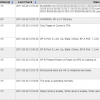Search Exchange
Search All Sites
Nagios Live Webinars
Let our experts show you how Nagios can help your organization.Login
Directory Tree
Directory
philipm
byphilipm, April 8, 2022
1 of 1 people found this review helpful
I'm getting an error when the plugin is trying to parse the output of "multipath -l". This happens when the mulltipath service is stopped.
#multipath -ll
lun-name (xxxx) dm-6 NETAPP ,LUN C-Mode
size=400G features='3 pg_init_retries 50 retain_attached_hw_handler' hwhandler='1 alua' wp=rw
|-+- policy='service-time 0' prio=50 status=active
| |- 1:0:1:0 sdb 8:16 active ready running
| |- 1:0:2:0 sdd 8:48 active ready running
| |- 2:0:2:0 sde 8:64 active ready running
| `- 2:0:4:0 sdg 8:96 active ready running
`-+- policy='service-time 0' prio=10 status=enabled
|- 1:0:5:0 sdf 8:80 active ready running
|- 1:0:7:0 sdh 8:112 active ready running
|- 2:0:1:0 sdc 8:32 active ready running
`- 2:0:5:0 sdi 8:128 active ready running
Apr 08 09:21:04 | multipath device maps are present, but 'multipathd' service is not running
Apr 08 09:21:04 | IO failover/failback will not work without 'multipathd' service running
#multipath -ll
lun-name (xxxx) dm-6 NETAPP ,LUN C-Mode
size=400G features='3 pg_init_retries 50 retain_attached_hw_handler' hwhandler='1 alua' wp=rw
|-+- policy='service-time 0' prio=50 status=active
| |- 1:0:1:0 sdb 8:16 active ready running
| |- 1:0:2:0 sdd 8:48 active ready running
| |- 2:0:2:0 sde 8:64 active ready running
| `- 2:0:4:0 sdg 8:96 active ready running
`-+- policy='service-time 0' prio=10 status=enabled
|- 1:0:5:0 sdf 8:80 active ready running
|- 1:0:7:0 sdh 8:112 active ready running
|- 2:0:1:0 sdc 8:32 active ready running
`- 2:0:5:0 sdi 8:128 active ready running
Apr 08 09:21:04 | multipath device maps are present, but 'multipathd' service is not running
Apr 08 09:21:04 | IO failover/failback will not work without 'multipathd' service running
Owner's reply
Up to version 0.4.11 the plugin could not handle those messages from the multipath call. The Issue should be fixed from version 0.4.12 onwards, I'm just (2022-04-12) testing a release candidate.
byphilipm, December 9, 2014
I hope you get this message.
The reason why you're getting different outputs from the browser than what's in the cli is because you could be using different user accounts for both. From the the browser itself, my best guess is the plugin is being executed as the 'nagios' user and you're using your own user account from the cli.
If you try running the script, from the cli, as the service account that is running Nagios I bet you'll get the same output that your browser is displaying.
It could have something to do with 'secfile'. Create/setup one as the service account used by Nagios and you should be set.
####
Nice script btw, this helps a lot in monitoring our storages devices.
The reason why you're getting different outputs from the browser than what's in the cli is because you could be using different user accounts for both. From the the browser itself, my best guess is the plugin is being executed as the 'nagios' user and you're using your own user account from the cli.
If you try running the script, from the cli, as the service account that is running Nagios I bet you'll get the same output that your browser is displaying.
It could have something to do with 'secfile'. Create/setup one as the service account used by Nagios and you should be set.
####
Nice script btw, this helps a lot in monitoring our storages devices.

 Directory
Directory New Listings
New Listings